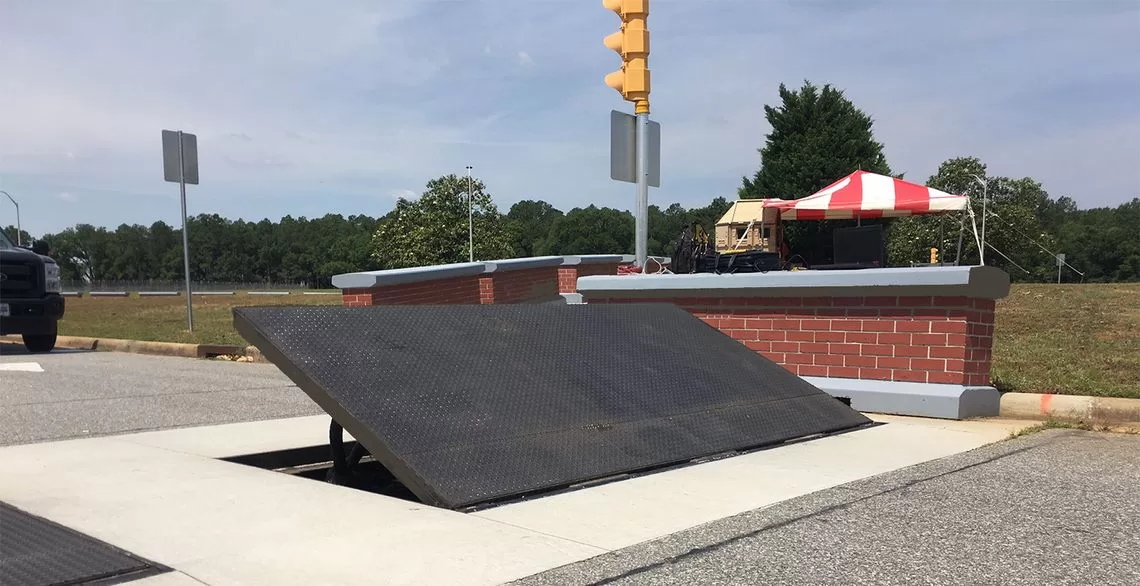Getting The Wedge Barriers To Work
Wiki Article
Facts About Wedge Barriers Uncovered
Table of ContentsWedge Barriers - QuestionsThe 4-Minute Rule for Wedge Barriers

14 and the surface area 12 to which the obstacle 10 is protected may be made from concrete - Wedge Barriers. 2, the obstacle 10 is mounted to or includes an anchor or subframe (e. g., anchor 30 shown in FIG. 2 )secured under the surface 12. The bather 10 might be bolted to the support or secured to the support by various other mechanical fasteners. In the illustrated embodiment, the obstacle 10 consists of a wedge plate 16, which consists of a section that is considerably parallel with the surface 12 when the barrier 10 remains in the pulled back setting. Simply put, cars or people might pass over the barrier 10 when the obstacle 10 is in the retracted setting and experience minor elevation loved one to the surface area 12 while on the barrier 10. As reviewed in detail listed below, when the obstacle 10 is in the released setting, the wedge plate 16 is held and supported in an elevated position by a training device of the obstacle 10. In addition, the elements 18 may be bolted or otherwise mechanically combined to one another. In this fashion, repair work or replacement of one or even more elements 18 might be simplified and structured. That is, repair work or substitute of single parts 18 may be done quicker, easily, and expense effectively. FIG. In certain personifications, the anchor 30 may be a steel structure including plates, beam of lights(e. g., I-beams ), and/or various other structures that are safeguarded within the foundation 14, which may be concrete. At the surface area 12, an upper side 28 of the click site anchor 30 might go to the very least partly revealed , thus enabling the accessory of the obstacle 10 to the support 30. g., threaded openings)in several beam check my reference of lights or plates of the support 30 might be subjected to the surface area 12. In this manner, bolts 32 or various other mechanical fasteners might be used to secure the barrier 10 to the anchor 30. As the obstacle 10 is placed to the surface area 12 of the structure 14, collection of debris and other material underneath the barrier might be lowered, and parts of the bather 10 might not be revealed to below quality settings. As shown by referral numeral 52, the lifting mechanism 50 includes elements got rid of underneath the wedge plate 16. As an example, the parts 52 beneath the wedge plate 16 may consist of an electromechanical actuator, a camera, several webcam surfaces, and so forth. Additionally, the lifting system 50 consists of a springtime setting up 54
The springtime pole 58 is combined to a webcam(e. g., web cam 80 received FIG. 4) of the training Check Out Your URL system 50. The springs 60 disposed concerning the springtime rod 58 are held in compression by spring supports 62, including a repaired spring assistance 64. That is, the set springtime assistance 64 is repaired loved one to the structure 14 et cetera of the bather 10.
The 2-Minute Rule for Wedge Barriers
g., springtime support 65 )might be fixed to completion of the springtime pole 58 to allow compression of the springtimes 60. As the springs 60 are pressed between the springtime sustains 62, the spring setting up 54 generates a force acting upon the cam coupled to the springtime pole 58 in a direction 66. The staying pressure used to the cam to deploy the wedge plate 16 may be provided supplied an electromechanical actuator 84 or other various other. The springtime setting up 54 and the actuator 84(e. g., electromechanical actuator)may operate with each other to convert the web cam and lift the wedge plate 16.
As discussed over, in the released placement, the wedge plate 16 serves to block accessibility or travel beyond the barrier 10. The barrier 10(e. g., the wedge plate 16 )might block pedestrians or cars from accessing a residential property or path. If a vehicle is traveling in the direction of the deployed wedge plate 16(e. For example, in one condition, the safety legs 86 may be prolonged duringmaintenance of the barrier 10.
Report this wiki page